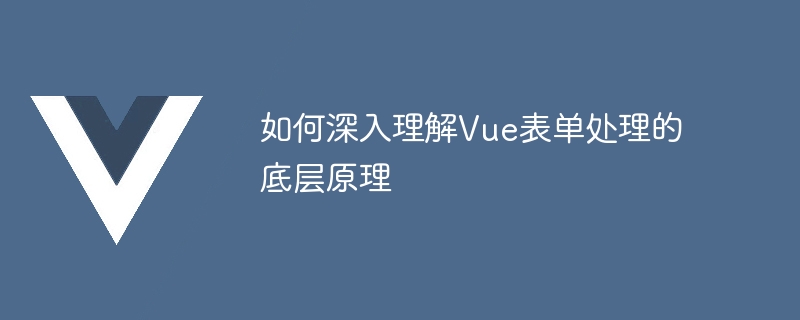Home >Web Front-end >Vue.js >How to deeply understand the underlying principles of Vue form processing
How to deeply understand the underlying principles of Vue form processing
- WBOYWBOYWBOYWBOYWBOYWBOYWBOYWBOYWBOYWBOYWBOYWBOYWBOriginal
- 2023-08-10 22:57:07905browse

How to deeply understand the underlying principles of Vue form processing
Introduction:
Vue is a popular JavaScript framework for building user interfaces. It provides powerful data binding capabilities and a flexible component-based development method, and is widely used in Web development. Forms are an integral part of web applications, and Vue provides many convenient ways to process form data. This article will focus on the underlying principles of Vue form processing to help readers deeply understand the working principle of Vue forms.
1. Vue form binding principle
- Form data binding
In Vue, we can use the v-model instruction to combine the form element with the data attribute in the Vue instance Perform two-way binding. For example, we can two-way bind the input box to the message in the data attribute through the following code:
<template>
<div>
<input v-model="message" type="text">
<p>{{ message }}</p>
</div>
</template>
<script>
export default {
data() {
return {
message: ''
}
}
}
</script>In this example, when the user enters content in the input box, the value of the message will As it changes, the text on the page will update.
- Form submission
When the form is submitted, we can use the v-on instruction to bind the submission event to a method in the Vue instance to process the form data. For example, we can submit form data through the following code:
<template>
<div>
<form v-on:submit.prevent="submitForm">
<input v-model="message" type="text">
<button type="submit">提交</button>
</form>
<p>{{ message }}</p>
</div>
</template>
<script>
export default {
data() {
return {
message: ''
}
},
methods: {
submitForm() {
// 处理表单提交逻辑
console.log(this.message);
}
}
}
</script>In this example, when the user clicks the submit button, the submitForm method will be called and the content in the input box will be output.
2. The underlying principle of Vue form processing
- Principle of form data binding
Vue's form data binding is completed by listening to input events and updating data. When the user inputs, Vue will automatically update the value of the data attribute in the Vue instance and reflect the new value on the page through the data response system. - Principle of form submission processing
Vue's form submission processing is completed through the v-on instruction and event monitoring. When the user clicks the submit button, Vue will trigger the bound method and pass the form data to the method for processing.
3. Code Example
The following is a simple code example that demonstrates the underlying principle of Vue form processing:
<template>
<div>
<form v-on:submit.prevent="submitForm">
<input :value="message" @input="updateMessage" type="text">
<button type="submit">提交</button>
</form>
<p>{{ message }}</p>
</div>
</template>
<script>
export default {
data() {
return {
message: ''
}
},
methods: {
submitForm() {
console.log(this.message);
},
updateMessage(event) {
this.message = event.target.value;
}
}
}
</script>In this example, we bind it through :value The value of the input box is determined, the input event is monitored through @input, and the message value in data is updated through the updateMessage method. When the user clicks the submit button, the submitForm method will be called and the contents of the input box will be output.
Conclusion:
By deeply understanding the underlying principles of Vue form processing, we can better understand the working principle of the Vue framework and effectively develop and debug Vue forms. I hope this article can provide some help and inspiration to readers.
The above is the detailed content of How to deeply understand the underlying principles of Vue form processing. For more information, please follow other related articles on the PHP Chinese website!
Related articles
See more- About vue using validator: VeeValidate3
- What are the differences between computed and method in Vue?
- Introduction to the method of turning off Eslint verification in the vue project
- Introduction to several methods of defining component templates in Vue.js
- Four places to implement AJAX in Vue applications

